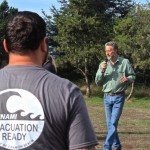

Cannon Beach, Ore. – This past weekend, Cannon Beach held its second annual Race the Wave run for tsunami preparedness. FEMA Corps provided support for the event along with several local and regional partners. The team of eight FEMA Corps members, known as Blue Two, is serving in the FEMA Region X office in Bothell, Washington. Blue Two arrived in Bothell September 3rd and will be in the area until November 12th.Their previous projects included a supporting role with the Central Coast Red Cross in California and FEMA Region VI in New Orleans, Louisiana.

Cannon Beach Mayor Sam Steidel speaks to partners and participants prior to Race the Wave. In its second year the event continues to spread a message of tsunami preparedness. The event ended at one of the cities cache storage sites, where there was a preparedness fair open to race participants and the local community.
Race the Wave gave participants the option of running, walking, or rolling through different courses that began at the beach, leading onto the tsunami evacuation route and up to the designated assembly area, where they finished at a Disaster Preparedness Fair. The Preparedness Fair featured fun and interactive booths from various organizations including the American Red Cross and the Oregon Office of Emergency Management (OEM) for families and persons of all ages to learn how to properly prepare for a potential earthquake and tsunami.
Cannon Beach is a prime location for the event since it is a coastal community with a high volume of tourism year round. However, despite being community based for the past two years, its intention is to send a broader message about the prevalent tsunami hazard along coastlines. Populations vulnerable to this type of disaster stretch from Alaska all the way down to the coast of California. FEMA Region X hopes this event and others like it will encourage communities to become active in preparedness and spread the message.
Cannon Beach is home to a cache storage system that is stocked and maintained by its citizens. Mayor Sam Steidel had this to say on their system, “Involving our citizens in community preparedness gives us an educated volunteer base that will be of great importance in the event of emergencies. In the future we hope to seek further improvement in our efforts by cooperating with other coastal communities for outreach events like Race the Wave.”
Blue Two assisted the Cannon Beach Children’s Center and Clatsop County Emergency Management with logistical efforts including race route support and gathering content for social media. The team found collaborative efforts between organizations to be interesting, such as the Oregon Office on Disability & Health to the Oregon Department of Geology and Mineral Industries. The team was eager to participate in the event understanding the potential impact it could have.
The AmeriCorps National Civilian Community Corps (NCCC) and its FEMA Corps units engage 2,800 young Americans in a full-time, 10-month commitment to service each year. AmeriCorps NCCC members address critical needs related to natural and other disasters, infrastructure improvement, environmental stewardship and conservation, and urban and rural development; FEMA Corps members are solely dedicated to disaster preparedness, mitigation, response and recovery work. The programs are administered by the Corporation for National and Community Service (CNCS). CNCS is the federal agency that engages more than five million Americans in service through its AmeriCorps, Senior Corps, Social Innovation Fund, and Volunteer Generation Fund programs, and leads President’s national call to service initiative, United We Serve. For more information, visit NationalService.gov.
Visit source –


